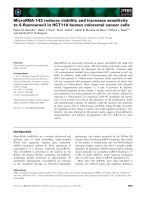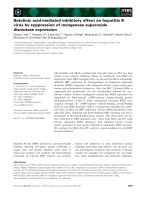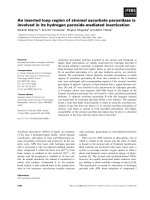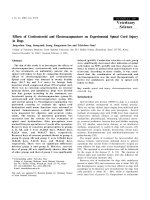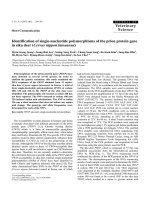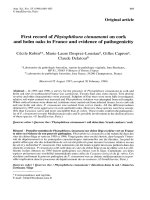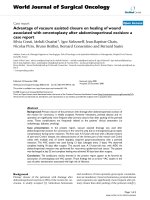Báo cáo khoa học: "Rib fracture after stereotactic radiotherapy on follow-up thin-section computed tomography in 177 primary lung cancer patients" potx
Bạn đang xem bản rút gọn của tài liệu. Xem và tải ngay bản đầy đủ của tài liệu tại đây (1.01 MB, 34 trang )
This Provisional PDF corresponds to the article as it appeared upon acceptance. Fully formatted
PDF and full text (HTML) versions will be made available soon.
Rib fracture after stereotactic radiotherapy on follow-up thin-section computed
tomography in 177 primary lung cancer patients
Radiation Oncology 2011, 6:137 doi:10.1186/1748-717X-6-137
Atsushi Nambu ()
Hiroshi Onishi ()
Shinichi Aoki ()
Tsuyota Koshiishi ()
Kengo Kuriyama ()
Takafumi Komiyama ()
Kan Marino ()
Masayuki Araya ()
Ryo Saito ()
Lichto Tominaga ()
Yoshiyasu Maehata ()
Eiichi Sawada ()
Tsutomu Araki ()
ISSN 1748-717X
Article type Research
Submission date 10 July 2011
Acceptance date 13 October 2011
Publication date 13 October 2011
Article URL />This peer-reviewed article was published immediately upon acceptance. It can be downloaded,
printed and distributed freely for any purposes (see copyright notice below).
Articles in Radiation Oncology are listed in PubMed and archived at PubMed Central.
For information about publishing your research in Radiation Oncology or any BioMed Central journal,
go to
/>Radiation Oncology
© 2011 Nambu et al. ; licensee BioMed Central Ltd.
This is an open access article distributed under the terms of the Creative Commons Attribution License ( />which permits unrestricted use, distribution, and reproduction in any medium, provided the original work is properly cited.
For information about other BioMed Central publications go to
/>Radiation Oncology
© 2011 Nambu et al. ; licensee BioMed Central Ltd.
This is an open access article distributed under the terms of the Creative Commons Attribution License ( />which permits unrestricted use, distribution, and reproduction in any medium, provided the original work is properly cited.
Rib fracture after stereotactic radiotherapy on follow-up thin-section computed
tomography in 177 primary lung cancer patients
*Atsushi Nambu
1
, Hiroshi Onishi
1
, Shinichi Aoki
1
, Tuyota Koshiishi
1
,
Kengo Kuriyama
1
Takafumi Komiyama
2
, Kan Marino
3
, Masayuki Araya
1
, Ryo Saito
1
, Lichto Tominaga
1,
Yoshiyasu Maehata
1
, Eiichi Sawada
1
,Tsutomu Araki
1
1) Department of Radiology, University of Yamanashi, Chuo City, Japan
2) Department of Radiology, Kofu Municipal Hospital, Kofu City, Japan
3) Department of Radiology, Yamanashi Prefectural Hospital, Kofu City, Japan
*Corresponding author; Atsushi Nambu
Address: Department of Radiology, University of Yamanashi, Shimokawato 1110, Chuo City,
Yamanashi Prefecture, Japan, ZIP code:409-3898
Phone:+81-552-273-1111 FAX: +81-552-273-6744
E-mail:
Abstract
Background: Chest wall injury after stereotactic radiotherapy (SRT) for primary lung
cancer has recently been reported. However, its detailed imaging findings are not
clarified. So this study aimed to fully characterize the findings on computed
tomography (CT), appearance time and frequency of chest wall injury after stereotactic
radiotherapy (SRT) for primary lung cancer
Materials and Methods: A total of 177 patients who had undergone SRT were
prospectively evaluated for periodical follow-up thin-section CT with special attention
to chest wall injury. The time at which CT findings of chest wall injury appeared was
assessed. Related clinical symptoms were also evaluated.
Results: Rib fracture was identified on follow-up CT in 41 patients (23.2%). Rib
fractures appeared at a mean of 21.2 months after the completion of SRT (range, 4 -58
months). Chest wall edema, thinning of the cortex and osteosclerosis were findings
frequently associated with, and tending to precede rib fractures. No patients with rib
fracture showed tumors >16mm from the adjacent chest wall. Chest wall pain was seen
in 18 of 177 patients (10.2%), of whom 14 patients developed rib fracture. No patients
complained of Grade 3 or more symptoms. Conclusion: Rib fracture is frequently seen
after SRT for lung cancer on CT, and is often associated with chest wall edema, thinning
of the cortex and osteosclerosis. However, related chest wall pain is less frequent and is
generally mild if present.
Key words: stereotactic radiotherapy, lung cancer, rib fracture, thin-section CT
Background
Stereotactic radiotherapy (SRT) for primary lung cancer has recently attracted attention
because of its promising treatment effects [1-10]. A recent report demonstrated that SRT
achieved a good survival rate for patients with non-small cell lung carcinoma,
comparable to those of surgery [10]. SRT has now been applied not only to medically
inoperable patients but also to operable ones. In the near future, SRT might become an
alternative treatment to surgery for stage I non-small lung carcinoma.
One major concern that must always been taken into consideration when selecting
treatment methods is treatment sequelae. SRT is generally considered a safe treatment,
with fewer complications than surgery. However, several studies have reported
complications in SRT, such as radiation pneumonitis [11, 12] and chest wall injury,
including rib fracture [5-7, 13-16]. Frequencies of rib fracture after SRT have already
been reported in several investigations. However, detailed CT findings of chest wall
injury have yet to be clarified.
The present study therefore aimed to fully characterize detailed CT findings of chest
wall injury after SRT for primary lung cancer using thin-section CT.
Methods
The institutional review board approved all study protocols. Written informed consent
was obtained from all patients prior to participation in this study.
Patients
Between November 2001 and April 2009, a total of 210 patients with primary
non-small cell lung carcinoma underwent SRT in our institution. Of these patients, 177
patients agreed to participate in this prospective study. Patient characteristics are
summarized in Table 1.
Methods of radiotherapy
SRT was performed using noncoplanar 10 dynamic arcs. A total dose of 48-70Gy at
the isocenter was administered in 4-10 fractions, and approximately 80% isodose line of
prescribed dose covered planning target volume (PTV) using a 6 MV X-ray, comprising
three different methods, namely 48Gy/4fractions, 60Gy/10fractions, and
70Gy/10fractions, (Table 1). We essentially used 60Gy/10fractions but when tumor
measured more than 3cm (i.e. T2) 70Gy/10fractions was used, and cases that were
registered in a certain clinical trial were treated with 48Gy/4fractions. The dose was not
constrained by surrounding normal tissues including chest wall. Heterogeneity
corrections were made in all cases.
After adjusting the isocenter of the PTV to the planned position in a unit comprising a
CT scanner and linear accelerator, irradiation was performed under patient-controlled
breath-holding and radiation beam switching.
CT examination
Preradiotherapeutic and follow-up CT were performed using the same 16 multidetector
row scanner (Aquilion 16 (Toshiba Medical Systems, Otawara, Japan)) and with the
identical protocols.
Parameters for CT scanning were as follows: peak voltage 120 kVp, tube rotation time
0.5 second, slice collimation 1.0 mm, and beam pitch 0.94. Tube currents were
determined by an automatic exposure control with the noise factor for determining the
applied tube current was set at 11 (standard deviation) and the tube currents actually
ranging from 110 to 400mA.
Contrast-enhanced CT was performed for 116 patients (67.1%) after unenhanced CT.
Contrast material (Omnipaque 300, Daiichi Sankyo, Tokyo) in a volume tailored to the
body weight of each patient (600 mg iodine/ kg body weight) was injected from the
anterior cubital vein within a fixed injection time of 50 s (i.e. injection rate was
variable.). CT scans were started at 60 and 120 s after beginning of the contrast
injection.
These data were reconstructed into 5mm sections. Thin-section CT (slice thickness,
1mm) was also produced for regions that included tumor or radiation-induced opacities
targeting the affected lung, which was mainly used for the evaluation of chest wall
injury.
Preradiotherapeutic CT was performed within 1 month before SRT, while follow-up
CT was performed at 3 and 6months after the completion of the radiotherapy, and every
6 months thereafter.
CT evaluation
Preradiotherapeutic CT was interpreted by either of two chest radiologists (A.N, E.S)
in our institution. Maximum tumor size and the shortest distance between the tumor
margin and chest wall (tumor-chest wall distance) were measured on 1mm
contrast-enhanced CT with a reconstruction kernel for viewing lung parenchyma as a
part of the radiology report. Maximum tumor size was defined as the maximum
dimension of a tumor in all of axial CT sections that included the tumor.
Follow-up CT was also examined by either of the same radiologists with special
attention to abnormal findings of the chest wall in addition to routine radiological
assessment. Rib fracture in this study was defined as a disruption of cortical continuity
with malalignment. Thinning of cortex was defined as a focal area of cortex with a
thickness less than half of the surrounding normal cortex. Osteosclerosis was defined as
an area of increased attenuation comparable to cortex in the medulla of rib.
The time at which each finding first appeared after the completion of SRT was
reviewed. Final outcomes of rib fractures during the follow-up period were also
assessed on follow-up CT.
Follow-up of patients
Every patient was basically asked to visit our clinic at 3, 6, and every 6 months
thereafter after the completion of radiotherapy. At every visit, a thorough examination
was performed, consisting of inquiry focusing on pain at the chest wall near the
irradiated tumor and respiratory symptoms, physical examination by an attending
radiation oncologist, blood test, and CT. Clinical symptoms considered related to chest
wall injury after SRT were graded according to the criteria for pain in Common
Terminology Criteria for Adverse Events, version. 3. Chest radiologists interpreted the
results of CT just after the examinations. If the patient complained of pain, analgesics
were prescribed as appropriate.
Evaluation of dosimetry
Among the 177 patients, detailed dosimetries were available for review in 26 patients
with rib fracture and 22 patients without. Patients without fracture were randomly
sampled among those with no evidence of fracture on CT for more than 30 months. We
set this period as a cut-off point as most rib fractures after SRT in this series had
occurred within 30 months after completion of SRT. At the point on the chest wall that
had received the maximum dose, BED was calculated in each case assuming the α/β
ratio as 3 (BED
3
) (Fig 1). The chest wall volume (cc) that received in BED
3
>50 Gy was
also calculated.
Data analysis
Data analyses were performed retrospectively using the prospectively interpreted
radiology reports.
First, we calculated the crude incidence of rib fracture after SRT on follow-up CT
during the follow-up periods of the patients. As crude incidence may underestimate
actual incidence of rib fracture, we also performed a Kaplan-Meier method to obtain a
more accurate estimate of incidence of rib fracture. We also assessed the relationship
between rib fracture and related findings in terms of time frame.
Second, we determined the threshold tumor-chest wall distance on preradiotherapeutic
CT to discriminate patients who with rib fractures from those without. Frequencies of
rib fracture when the tumor-chest wall distance was less than or equal to the threshold
distance and when the distance was 0mm were also calculated.
Third, we evaluated the frequency of clinical symptoms.
Fourth, mean BED
3
and BED
3
>50 Gy were calculated in fracture and non-fracture
groups and were compared between the two groups using unpaired t test. Fisher’s exact
test or χ
2
test was used to see differences between groups.
Value of p<0.05 were considered statistically significant.
All statistical analyses were performed using IBM SPSS Statistics version 18(New
York, USA).
Results
Frequency of rib fractures after SRT
The crude incidence of rib fracture was 23.2% (41/177) at a median follow-up of 27
months (Table 2). The frequency of rib fracture was not statistically different among the
three different dose fractionations (χ2 test, p=0.391). Kaplan-Meier method estimated
the incidence to be 27.4% at 24 months.
Imaging findings of rib fracture and related findings and appearance times
Results of appearance time and frequency of rib fractures are summarized in Table 2.
Rib fractures appeared at a mean of 21.2 months (range, 4 -58 months ) on follow-up
CT. Fractures invariably occurred at the ribs close to the irradiated tumor, and were
solitary or multiple (Fig.2). Final outcomes for fractures were non-union in 28 patients,
including 14 patients with pseudoarthrosis (defined as covering of cortex over the
fractured surface), and bony union in 13. Chest wall edema was seen in 45 of 177
patients (25.4%), appearing at a mean of 12 months after SRT (range, 2 -57 months).
Such edema was seen as asymmetrical swelling of the ipsilateral chest wall compared
with the contralateral chest wall along with effacement of interlaced intramuscular fat
attenuation. Low-attenuation areas in the chest wall were occasionally associated, which
became more conspicuous on contrast- enhanced CT (Fig. 3). Thinning of the cortex
was observed in 36 patients (30.3%) at 4 to 36 months. Osteosclerosis was evident in 26
patients (14.7%) on follow-up CT at a mean of 15 months (range, 4-57 months). This
finding appeared as mottled sclerosis of the affected bone (Fig. 4). These findings
related to rib fracture typically preceded the identification of rib fracture.
Symptoms of rib fracture
Clinical symptoms in patients with rib fracture and without rib fracture are summarized
in Table 3. Chest wall pain was seen in 18 of 177 patients (10.2%), of whom 14 patients
developed rib fracture. No patients complained of Grade 3 or more symptoms. Four
patients without rib fractures complained of Grade 1 chest wall pain with all 4 cases
showing radiological evidence of chest wall edema. In the study population as a whole,
the frequency of chest wall pain was 21.5% (38/177). The frequency of chest wall pain
was not significantly different between the patients with union (6/13, 46%) and
non-union (7/28, 25%) rib fracture (Fisher’s exact test, p=0.160).
Threshold tumor-chest wall distance in the occurrence of rib fracture
Mean tumor-chest wall distance was 12.3mm (range, 0 - 53mm). No patients with rib
fracture showed a tumor-chest wall distance >16mm, while frequency of rib fracture
was 31.3% (41/131) for a distance <16mm, and 37.1% at 24 months by Kaplan-Meier
method. When the distance was 0mm, frequency of rib fracture was 36.7 % (22/60) and
51.8% at 24 months by Kaplan-Meier method (Table 4).
Maximum BED3 of the chest wall in patients with and without rib fracture, and
threshold dose for rib fracture occurrence
Mean BED3 of the chest wall was 240.7±38.7 in 26 patients with rib fracture and
146.8±74.5 in 22 patients without rib fracture, representing a significant difference
between groups (p<0.001). The lowest BED3 that resulted in rib fracture was 152.4 Gy.
Mean chest wall volume (cc) with BED3 >50Gy was 110.3±45.0cc in the fracture group
and 50.1±59.8 in the non- fracture group, again representing a significant difference
(p<0.001). The minimum volume that resulted in rib fracture was 25cc.
Discussion
Our results demonstrated that the development of rib fracture after SRT is not
uncommon with a frequency of 23.2% for the whole study population. Not unexpectedly,
frequency increased with closer proximity of the tumors to the chest wall, from 31.3%
<16mm to 36.7% at 0mm. The reported frequencies of rib fracture after SRT vary
widely among investigators, ranging from 3% to 21.2% [5-7, 13-16]. Our result is
closest to that reported by Petterson, et al., who reported the highest frequency (21.2%)
among the previous reports [14]. We speculate that these discrepancies are mainly
caused by differences in the methods for estimating frequency. Petterson, et al. and the
present study obtained frequencies based on follow-up CT, whereas other studies based
frequencies on findings for patients who complained symptoms. That is, differences
may be largely due to whether asymptomatic patients with rib fracture were likely to be
included in frequency calculations. Our clinical experience supports this speculation.
Differences in follow-up periods, methods of SRT or the proportion of tumors close to
the chest wall may also have contributed to the discrepancies between studies. The
frequency of rib fracture reported by Petterson, et al. is still lower than our result despite
the fact that they used a higher prescribed SRT dose than we did. This may be because
thin-section CT in the present study may have allowed sensitive detection of rib
fracture.
In Kaplan-Meier method, the frequency of rib fracture was calculated to be even
higher (27.4% at 24 months). This incidence is considered to be a more accurate
estimate of frequency of rib fracture as there were censored cases during the follow-up
periods.
The frequency of rib fracture is also more common in SRT for lung cancer than in
breast conserving surgery combined with radiotherapy, which has a reported frequency
of 0.3-2.2% [17,18], probably due to much higher dose delivered to the rib in SRT when
tumors are close to the chest wall.
Rib fractures occurred at a mean of 21.2 months (range, 4-58 months) after SRT,
mostly within 30 months after completion of SRT, and were frequently preceded by
chest wall edema, thinning of the cortex of the rib or sclerosis of the medulla of the rib.
We may summarize the typical course of chest wall injury after SRT as depicted on
thin-section CT as follows: at several months after SRT chest wall edema first appears.
The cortex then becomes thinner and the medulla sometimes becomes sclerotic in a
mottled fashion, and the affected rib eventually undergoes fracture. These CT findings
presumably correspond to soft tissue edema and changes in bone vascularity due to
increased permeability or occlusion of the capillaries caused by irradiation of the soft
tissue, and a decrease in number of osteoblasts resulting in decreased collagen
production, in turn causing osteopenia and subsequent bone injury [19]. Osteosclerosis
after radiotherapy is considered to represent reactive bone formation caused by
remaining osteoblast cells [20].
Under such conditions, the rib becomes extremely vulnerable and often fractures.
Although these bone changes may actually represent insufficiency fracture [19],
radiation osteitis [21], callous formation secondary to microtrabecular fracture or
osteonecrosis [22], we did not use these terms as we had no pathological confirmation
of such findings. We therefore employed the common terms for imaging findings.
We think that these preceding findings may be usable as predictors of rib fracture.
Prediction of rib fracture may be informative to the referring physicians as well as to
patients as we might initiate treatment for chest wall pain related to the forthcoming rib
fracture in advance or possibly take some preventive measures against rib fractures.
Although the frequency of clinical symptoms was not high in patient with rib fracture
and the clinical symptoms were generally not severe, most symptomatic patients had rib
fracture. Therefore, prediction of rib fracture will clinically be important.
In addition, bone sclerosis or focal loss of cortex may be mistaken for metastasis.
Familiarity with these findings will therefore minimize the potential for confusion.
The outcomes of rib fracture were non-union in 28 patients, including 14 patients with
pseudoarthrosis and bony union in 13. Needless to say, the proportion of union and
non-union largely depends on the duration of follow-up and the prescribed dose to
tumors. However, we can at least say that a substantial proportion of rib fractures after
SRT for lung cancer can remain a state of non-union for a long time after SRT and that
pseudoarthrosis is not uncommon. However, the outcomes of rib fracture seem
unrelated to the frequency of clinical symptoms.
A tumor-chest wall distance of 16 mm appears to represent a threshold value, beyond
which rib fracture did not occur, in our series. This threshold offers a concise and
convenient reference value. Undoubtedly, the risk of rib fractures depends much more
on the dose delivered to the rib and therefore a dosimetry-based evaluation can provide
a more accurate estimate of the risk of rib fractures. However, dosimetry can only be
produced after SRT is chosen as the treatment. Our approach can provide a patient or
referring physician with information about the risk of rib fracture based only on
preradiotherapeutic CT before decision is made to undergo SRT. Our result may not be
simply applicable to patients in other institutions as prescribed doses differ among
institutions, but will be valid when prescribed doses are less than or equal to our own.
Mean BED
3
of the chest wall (240.7±38.7 Gy) and mean chest wall volume (cc) with
BED
3
>50Gy (110.3±45.0cc) in 26 patients with rib fracture were much higher than
those (146.8±74.5Gy and 50.1±59.8cc) in 22 patients without rib fracture, with
statistical significances, respectively. These values may also be usable to predict the risk
of rib fracture. The lowest BED
3
that resulted in rib fracture was 152.4Gy. The threshold
BED
3
for producing rib fracture seemed to be around 150Gy, but further investigation is
necessary to make a definitive conclusion.
This study has some limitations that must be considered. First, we regarded the
appearance time of rib fracture and other related findings as that when these findings
were first seen on follow-up CT. However, these events would actually have occurred
within the interval of time since the previous CT. The present study would thus have
overestimated time that elapsed until these events.
Second, for BED
3
of chest wall, only a small number of cases from the study
population were sampled. This was because of the limited capability of our treatment
planning computer for data handling, which requires a substantial amount of time to
reproduce a dosimetry. Calculating dosimetries of all cases is obviously the best way to
obtain a threshold BED, but we believe that our random sampling method provided a
clear and concise reference value, which would offer a benchmark when considering
risk of rib fracture in clinical practice. Third, the method of SRT for lung cancer has yet
to be standardized. So, our results cannot be simply applied to other institutions.
Conclusion
Rib fracture is seen with high frequency after SRT for lung cancer when the tumor is
close to the chest wall. Chest wall edema and thinning and osteosclerosis of the cortex
represent related findings that often precede rib fracture and might be predictive of a
forthcoming rib fracture. However, related chest wall pain is less frequent and is
generally mild if present.
Competing interests
We declare that we have no competing interests regarding this study.
Authors’ contribution
All authors approved read and approved the final version of this paper. A.N is the first
author of this paper involved in interpretation of CT, clinical data collection, statistical
analysis and drafting this paper. H.O carried out clinical data collection, supervision of
this study, editing and approving the paper. S.A carried out clinical data collection,
dosimetry calculation and revision of clinical data. T.K, E.S and L.T carried out
collection of CT data and clinical data. K.K, T.K, K.M, M.A, R.S and Y.M carried out
clinical evaluations of patient at follow-up visits. T.A carried out supervision of this
study and final approval of this paper.
References
1. Uematsu M, Shioda A, Suda A, Fukui T, Ozeki Y, Hama Y, Wong JR, Kusano S:
Computed tomography-guided frameless stereotactic radiotherapy for stage I
non-small cell lung cancer: a 5-year experience. Int J Radiat Oncol Biol Phys 2001,
51:666-670.
2. Onishi H, Araki T, Shirato H, Nagata Y, Hiraoka M, Gomi K, Yamashita T, Niibe Y,
Karasawa K, Hayakawa K, Takai Y, Kimura T, Hirokawa Y, Takeda A, Ouchi A,
Hareyama M, Kokubo M, Hara R, Itami J, Yamada K: Stereotactic hypofractionated
high-dose irradiation for stage I nonsmall cell lung carcinoma: clinical outcomes in
245 subjects in a Japanese multiinstitutional study. Cancer 2004,10:1623-1631.
3. Nagata Y, Takayama K, Matsuo Y, Norihisa Y, Mizowaki T, Sakamoto T, Sakamoto
M, Mitsumori M, Shibuya K, Araki N, Yano S, Hiraoka M: Clinical outcomes of a
phase I/II study of 48 Gy of stereotactic body radiotherapy in 4 fractions for
primary lung cancer using a stereotactic body frame. Int J Radiat Oncol Biol Phys
2005, 63:1427-1431.
4. Onishi H, Shirato H, Nagata Y, Hiraoka M, Fujino M, Gomi K, Niibe Y, Karasawa
K, Hayakawa K, Takai Y, Kimura T, Takeda A, Ouchi A, Hareyama M, Kokubo M,
Hara R, Itami J, Yamada K, Araki T: Hypofractionated stereotactic radiotherapy
(HypoFXSRT) for stage I non-small cell lung cancer: updated results of 257
patients in a Japanese multi-institutional study. J Thorac Oncol 2007, 2 (7 Suppl
3):94-100.
5. Nyman J, Johansson KA, Hultén U: Stereotactic hypofractionated radiotherapy for
stage I non-small cell lung cancer mature results for medically inoperable patients.
Lung Cancer 2006, 51:97-103.
6. Zimmermann FB, Geinitz H, Schill S, Thamm R, Nieder C, Schratzenstaller U,
Molls M: Stereotactic hypofractionated radiotherapy in stage I (T1-2 N0 M0)
non-small-cell lung cancer (NSCLC). Acta Oncol 2006, 45:796-801.
7. Fritz P, Kraus HJ, Blaschke T, Mühlnickel W, Strauch K, Engel-Riedel W,
Chemaissani A, Stoelben E: Stereotactic, high single-dose irradiation of stage I
non-small cell lung cancer (NSCLC) using four-dimensional CT scans for treatment
planning. Lung Cancer 2008, 60:193-199.
8. Haasbeek CJ, Lagerwaard FJ, de Jaeger K, Slotman BJ, Senan S: Outcomes of
stereotactic radiotherapy for a new clinical stage I lung cancer arising
postpneumonectomy. Cancer 2009, 115:587-594.
9. Inoue T, Shimizu S, Onimaru R, Takeda A, Onishi H, Nagata Y, Kimura T,
Karasawa K, Arimoto T, Hareyama M, Kikuchi E, Shirato H: Clinical outcomes of
stereotactic body radiotherapy for small lung lesions clinically diagnosed as
primary lung cancer on radiologic examination. Int J Radiat Oncol Biol Phys
2009,75:683-687.
10. Onishi H, Shirato H, Nagata Y, Hiraoka M, Fujino M, Gomi K, Karasawa K,
Hayakawa K, Niibe Y, Takai Y, Kimura T, Takeda A, Ouchi A, Hareyama M,
Kokubo M, Kozuka T, Arimoto T, Hara R, Itami J, Araki T: Stereotactic Body
Radiotherapy (SBRT) for Operable Stage I Non-Small-Cell Lung Cancer: Can
SBRT Be Comparable to Surgery? Int J Radiat Oncol Biol Phys. 2010, [Epub ahead
of print]
11. Barriger RB, Forquer JA, Brabham JG, Andolino DL, Shapiro RH, Henderson MA,
Johnstone PA, Fakiris AJ: A Dose-Volume Analysis of Radiation Pneumonitis in
Non-Small Cell Lung Cancer Patients Treated with Stereotactic Body Radiation
Therapy. Int J Radiat Oncol Biol Phys 2010, [Epub ahead of print]
12. Takeda A, Ohashi T, Kunieda E, Enomoto T, Sanuki N, Takeda T, Shigematsu N:
Early graphical appearance of radiation pneumonitis correlates with the severity of
radiation pneumonitis after stereotactic body radiotherapy (SBRT) in patients with
lung tumors. Int J Radiat Oncol Biol Phys 2010, 77:685-690.
13. Dunlap NE, Cai J, Biedermann GB, Yang W, Benedict SH, Sheng K, Schefter TE,
Kavanagh BD, Larner JM: Chest wall volume receiving >30 Gy predicts risk of
severe pain and/or rib fracture after lung stereotactic body radiotherapy. Int J Radiat
Oncol Biol Phys 2010,76:796-801.
14. Pettersson N, Nyman J, Johansson KA: Radiation-induced rib fractures after
hypofractionated stereotactic body radiation therapy of non-small cell lung cancer:
a dose- and volume-response analysis. Radiother Oncol. 2009, 91:360-368.
15. Voroney JP, Hope A, Dahele MR, Purdie TG, Franks KN, Pearson S, Cho JB, Sun A,
Payne DG, Bissonnette JP, Bezjak A, Brade AM: Chest wall pain and rib fracture
after stereotactic radiotherapy for peripheral non-small cell lung cancer. J Thorac
Oncol. 2009, 4:1035-1037.
16. Michael T Milano, Louis S Constine, Paul Okunieff: Normal tissue toxicity after
small field hypofractionated stereotactic body radiation. Radiation Oncology 2008,
3:36.
17. Pierce SM, Recht A, Lingos TI, Abner A, Vicini F, Silver B, Herzog A, Harris JR:
Long-term radiation complications following conservative surgery (CS) and
radiation therapy (RT) in patients with early stage breast cancer. Int J Radiat Oncol
Biol Phys. 1992, 23:915-923.
18. Meric F, Buchholz TA, Mirza NQ, Vlastos G, Ames FC, Ross MI, Pollock RE,
